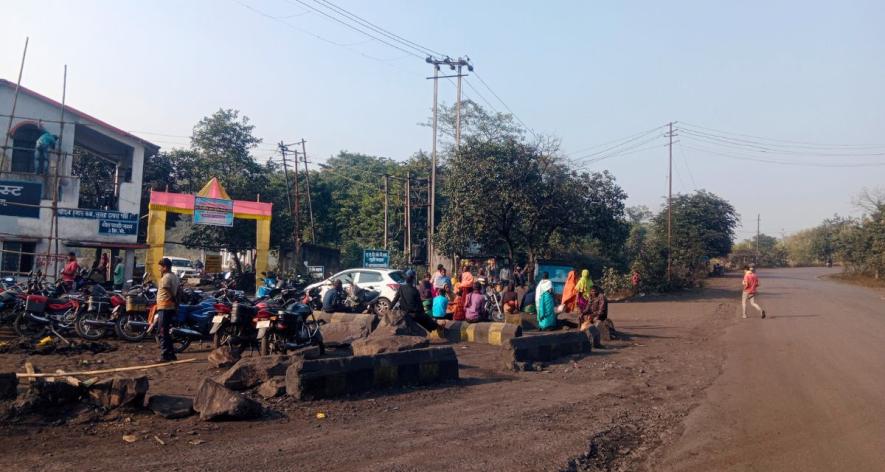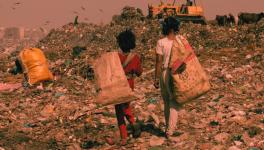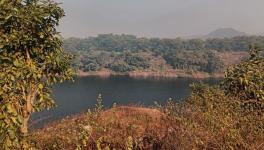Social Challenges Pin Down Just Transition Efforts in Bokaro

Bokaro, Jharkhand: It is evening and coal stoves have been lit in front of the houses of Karo Basti in Jharkhand’s Bokaro district to prepare dinner. Slowly, the narrow lanes get shrouded in a veil of smoke on that cold December dusk.
Surendra Ganjhu (60) and his wife Sukri Devi (55) are still outside, sitting dejected at the doorstep with their grandchildren. Surendra said his son Binod Kumar Ganjhu (29) had gone to Bengaluru to find work at the beginning of sawan (July 2023). He was found dead on the roadside soon after. “I do not know what happened,” he sighed.
Binod was forced to shift because he was without work for around eight months when Karo Opencast Coal Project (OCP) shut operations. There was only one mine under the project, but difficulties in land acquisition for project expansion led to the mine closure. After Binod's death, his wife Sunita Ganjhu started working as a coal loader at Balidih. According to her mother Budhani Devi, she leaves home by 7 am and returns only late in the evening.
“She is not only responsible for raising two children, but also looking after us elders,” said Surendra, who was into coal loading before advancing age and health issues stopped him from working. Sunita’s elder son aged eight is at school, while the younger aged three goes to Anganwadi.
"I do not get work every day, but when I do, I manage to earn Rs 400 to Rs 500 a day... Even the widow pension [Rs 1,000] eludes me because I have to go to Bengaluru to get Binod's death certificate," she lamented.
Apart from tribals and Scheduled Castes, Other Backward Classes and general category people live in Karo Basti, located barely four km from Bermo market. Coal mining has had a big impact on the village, with people's land acquired for it.
Incidentally, Bokaro is among the two districts selected in the country for the first phase implementation of a World Bank project that aims at helping India thoroughly plan its coal mine closures.
Depleting Resources
The irony of the coal industry is that some select mines are producing much coal, while others produce either very less or nil. Extensive use of technology, machines, and outsourcing have dented job availability. Mines are closing down due to several problems, including opposition to land acquisition by villagers, failure to get environmental clearance, overexploitation of the area, not having consent to operate from the state government and high production costs. Moreover, when the work gets more centralised, the employment prospects of people decrease.
Karo OCP is among the top 75 coal mines in the country in terms of coal production in the 2023-24 fiscal. Nevertheless, Coal India Limited (CIL) data suggest that only 34.38% of the production capacity has been achieved until February 6 this fiscal, while registering a negative growth of 51.10% in production.
According to sources in the Central Coalfields Limited (CCL), a subsidiary of CIL, the maximum production capacity of Karo OCP is 3.5 million tonnes (MT). Efforts are on to expand operations by acquiring land and by getting forest clearance from the Ministry of Environment, Forest and Climate Change. Once done, the mine capacity can increase between 11 and 15 MT.
However, despite its huge potential, employment and livelihood options remain bleak for the locals and the picture is not expected to change much even after its expansion.
Bharat Ganjhu (61) of Karo Basti is a mason. “My father and relatives jointly owned three acres and 44 decimals, but it was lost to the coal project decades ago. So, I want my sons to be employed in the coal mine. They go to Balidih to work as labourers now,” he said.
“The Directorate General of Mines Safety has allowed blasting work once the households have vacated, but the mine management is at it even before that,” he alleged.
To compound their misery, Karo Basti has been declared an urban area as it is close to Bermo town. “Groundwater has depleted due to mining, and our water needs are fulfilled by tankers that come once every eight days. Blasting causes cracks in houses. Apart from assurances and cases registered against us when we try to stop blasting or expansion of mining areas, we get nothing. Two to three cases have been registered against villagers for obstructing mine work," said Baban Rajak (53).
Surendra was also charged with a similar case, but he still thought the coal mine was necessary to ensure employment.
Operations Slow Down
Only 36 of the 68 CCL coal projects across the country are operational. Of the 13 coal mining areas under its control, three are in Bokaro district. In total, CCL has 19 coal mining projects in these three areas.
Of these 19 projects, 10 are open cast and eight underground. The remaining Sawang project is an opencast-underground mine. All underground mines are closed now, except Dhori-Khas mine. Many OCPs are also inoperative. Out of the five CCL coal washeries, Kathara, Sawang and Kargali washeries are in Bokaro district. Kathara and Sawang are still functional, but their capacities are very low.
Wishing anonymity, a CCL official told 101Reporters that the maximum production capacity of all three mining areas in Bokaro put together was 16.3 MT. The annual production capacity of Bokaro-Kargali was 9 MT, Dhori 4.6 MT and Kathara 2.7 MT. In the 2022-23 fiscal, these three areas produced 8.2 MT of coal and achieved 90% of the production target.
According to CCL sources, coal is produced as per the need and demand. The CCL's total production in 2022-23 was 76.087 MT, more than the target of 75.224 MT. Bokaro district contributed about 10.50% to the CCL’s total production. In the ongoing fiscal, the CCL’s production target is 84 MT.
Challenges in Just Transition
Last year’s Global Energy Monitor report stated that one direct employment in the coal sector generates four indirect jobs. There are currently 3,37,400 direct coal workers in India. By 2050, CIL, the largest employer in the coal industry in India, will lay off about 73,800 of its existing 3.08 lakh employees. China and India will be most affected by the decline in coal employment, and globally the figure will reach 100 workers per day by 2035.
According to a study focused on Jharkhand by energy sector think tank Climate Trends, there are 2,83,737 coal jobs in the state, which is 38% of India's total jobs in this sector. The study conducted in Bokaro, Dhanbad, Ramgarh, Ranchi and Chatra districts said that in view of the needs of thermal power, coal production will increase in the near future, but to achieve the net zero target, there has to be a phase down in coal production.
It said there was a lack of awareness at the ground level. Among the workers who participated in the study, 59% had no information about the mine closures. According to the study based on a sample survey of 6,000 workers, only 14% of people were aware of any plan of the government to reduce coal production in future. The level of awareness was even lower among the unorganised workers, which makes them more vulnerable to such shocks.
AITUC leader and member of the Joint Bipartite Committee for the Coal Industry Lakhanlal Mahato told 101Reporters that around 40,000 permanent coal workers were present in Bermo coalfield until 25 years ago. “The numbers have come down to 10,000. As a labour organisation, we are not against transition, but we want it to be fair.”
Steps Taken
In a written response to a question in the Lok Sabha, Coal Minister Prahlad Joshi stated on July 20, 2022, that the Ministry of Coal has received proposals from World Bank and GIZ (a German Development Agency) for assistance in development of India-specific Mine Closure Framework based on Just Transition Principles for closed and abandoned coal mines.
Subsequent to the approval of the Department of Economic Affairs to a grant-based technical assistance proposed in the World Bank’s Preliminary Project Report, phase one of the project began with the mapping of all closed and running mines, social survey, perception survey, and stakeholder consultations in Bokaro district, he added.
Korea in Chhattisgarh has also been selected for phase one. Of the total 38 mines in these two districts, 18 are not operational.
When contacted by 101Reporters, Bokaro Deputy Commissioner Kuldeep Chaudhary said he cannot comment on the World Bank plan, but spoke about the administration's efforts. "We are taking measures to empower the Panchayati Raj Institutions through various agencies. Every panchayat has its own different potential. We are assessing where agrarian, manufacturing, fisheries and alternative energy options are possible.”
Quizzed about dwindling job prospects, a CCL official in Bokaro district told 101Reporters on condition of anonymity that resources and technology have increased in coal mining. “People with expertise in different jobs have been hired. Private agencies are roped in. All these have improved both the quantity and quality of the coal mined. The present workforce ratio of CCL and private agencies is around 40:60. If employment has decreased in CCL, agency employment has increased,” he justified.
However, Mahato claimed they were no match. “The huge number of jobs lost could not be compensated by the outsourced jobs. The use of machines and technology have continuously reduced employment opportunities, despite the increase in production. Hence, it is necessary to reskill people. Employment possibilities should be explored in farming, alternative energy etc.,” he said.
Undoubtedly, transition is a slow process and the flux will continue for long.
(Rahul Singh is a Jharkhand-based freelance journalist and a member of 101Reporters, a pan-India network of grassroots reporters.)
Get the latest reports & analysis with people's perspective on Protests, movements & deep analytical videos, discussions of the current affairs in your Telegram app. Subscribe to NewsClick's Telegram channel & get Real-Time updates on stories, as they get published on our website.
























